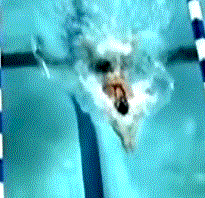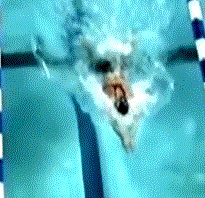HOW CHAMPIONS DO IT
Researched, produced, and prepared by Brent S. Rushall,
Ph.D., R.Psy.

AN OVERHEAD VIEW OF JESSICA HARDY'S ARM ACTION AT 45 m OF HER WINNING 50 m BREASTSTROKE A FINAL RACE AT THE 2010 PAN PAC SWIMMING CHAMPIONSHIPS
Jessica Hardy's time for this 50 m event was 30.03 seconds.
Only Jessica Hardy's arm action, specifically the locus of movement in the swimmer's frontal plane, is considered in this analysis. The main features of the swimmer's arms are a reduction in resistance and a reduction in inertial lag.
This stroke analysis includes a moving sequence in real time, a moving sequence where each frame is displayed for .5 of a second, and still frames.
The following image sequence is in real time. It will play through 10 times and then stop. To repeat the sequence, click the browser's "refresh" or "reload" button.

The following image sequence shows each frame for half a second. It will play through 10 times and then stop. To repeat the sequence, click the browser's "refresh" or "reload" button.

At the end of the following narrative, each frame is illustrated in detail in a sequential collage.
Notable Features
- Frame #1: The swimmer extends her body and arms forward during the late propulsive phase of her kick. Her head and shoulders are being lowered into the water.
- Frame #2: The arms are fully extended and the arms/hands positioned ready to spread apart. Her buoyant position leaves her back and buttocks exposed. Her "sinking" takes considerable time.
- Frame #3: The swimmer's arms/hands begin to spread as her head begins to be covered but her back remains exposed.
- Frame #4: The arms/hands continue to be spread. There is no attempt to produce an "outward scull" in the manner still commonly described in accounts of breaststroke technique.
- Frame #5: The arms/hands prepare to propel water backward. The arms continue to spread but the wrists flex so that the hands are facing backward and downward.
- Frame #6: The arms flex at the elbows and the hands are pitched to produce a force component that is directly backward. Significant propulsion begins at this stage. The head begins to rise. [It is likely that the swimmer's upper arms begin to medially rotate while the lower angles of the scapulae rotate outward. This re-positioning produces better propelling surfaces of the arms.]
- Frame #7: The upper arms abduct and the elbows continue to bend. The pressure on the hands is directly backward. Because of abduction of the upper arms, the surfaces of the whole arms are used to develop propulsive forces.
- Frame #8: Abduction of the upper arms continues as does flexion at the elbows. The head and shoulders rise. To generate forces to lift the head and shoulders, the forearms would be angled so that a vertical force component is generated to provide the lift.
- Frame #9: Propulsion through arm-generated forces ceases. The hands are well in front of the line of the face. The upper arms are not fully abducted and are still forward of the shoulder line. One could describe this action as being a "half-arm stroke". The head and shoulders continue to rise.
- Frame #10: The hands begin to come together well in front of the line of the face. They are raised as well. The elbows drop slightly. The head and shoulders are well clear of the water surface.
- Frame #11: The arms are extending forward. The rising and lengthening arms are followed by the elbows. It is likely that inhalation is fully underway at this time.
- Frame #12: The arms/hands continue to extend forward along the surface. Inhalation is completed. Extension of the shoulders forward, which is part of the arm extension, signals the beginning of the lowering of the head and shoulders.
- Frame #13: Extension of the arms along the surface continues.
- Frame #14: The extended arms are lowered deeper as the head and body fully extend because of a reaction to the completion of the backward phase of the kick. This position is very much like that in Frame #1.
- Frames #15 and #16: The stroke cycle is repeated.
Jessica Hardy's arm stroke cycle is very quick. It might seem short, but in swimming the largest movements often create more drag that more than offsets any increase in propulsion. In this stroke there is an absence of turbulence/resistance production.
- The elbows stay wide and follow the arms forward. There is no deliberate detrimental action of pulling the elbows into the side of the body.
- Inhalation occurs at the end of the am pull. A vertical force component of the pull is sufficient to support the breathing action. There is no deliberate "inward scull" that generates great resistance and some vertical force to support a late breathing action.
- After completion of the propulsive phase of the arms, the hands begin to move forward. An improvement might be to have them go directly to the position that is illustrated in Frame #13, rather than have them move inward and come together as in Frames #11 and #12.
In traditional breaststroke swimming, there is considerable excess arm movement comprising the inward scull followed by a long extension forward of both hands together. The traditional stroke has an extensive period of time where no propulsive force is generated and resistance is excessive because of the unnecessary and unproductive movements in the recovery. With Jessica Hardy's shortened stroke and fast recovery, the duration of the movement is lessened reducing the time in which the swimmer can decelerate (the period of inertial lag). This feature will support a higher rate as well as maintain the swimmer's velocity through lessening the opportunity to slow down.
Jessica Hardy's arm stroke is worthy of adoption as a technique feature for instruction. It might be improved if the recovery forward is more direct from the completion of the propulsive phase.

Return to Table of Contents for this section.

![]()



![]()